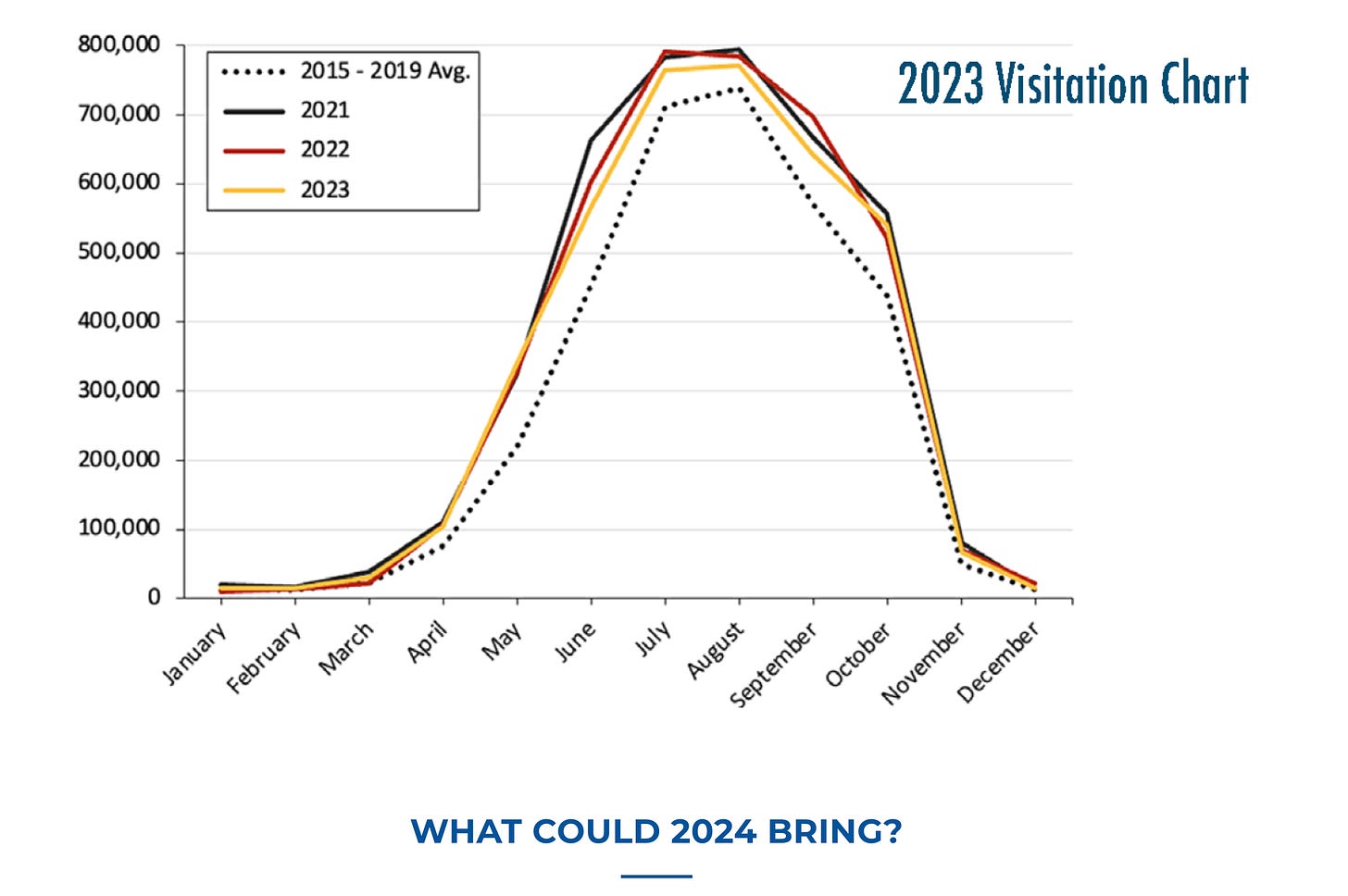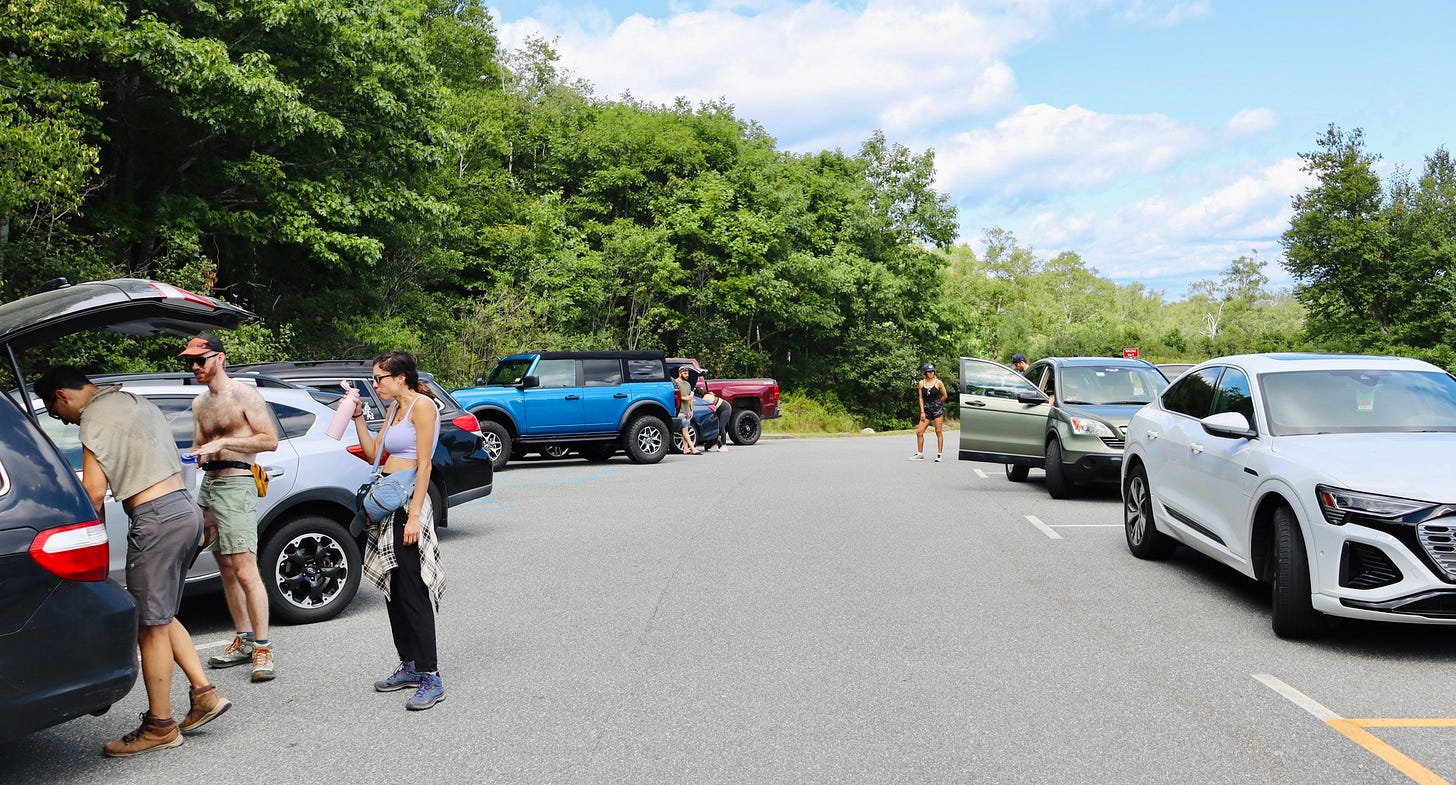Second Busiest August in History? Possibly, Park Official Says
As Acadia National Park Visitation Numbers Stay Steady, Agencies Work Toward Housing
The Bar Harbor Story is generously sponsored by Window Panes Home and Garden.
ACADIA NATIONAL PARK—How many people are visiting Acadia National Park this year?
So far, the amount of visitations (though not necessarily visitors) is coming in at 1.2% more than last year through July despite a 1.1% drop in visitations to the Schoodic portion of the park. The visitations number is approximately 1,860,830.
Preliminarily, August was the second busiest August on record, Park Superintendent Kevin Schneider told the Acadia Advisory Commission during its September 9 meeting. The busiest season for the 47,000 acre park was 2021 just after the pandemic, he said.
In 2021, the visitation numbers just surpassed 4 million. In 2023, those numbers decreased slightly to 3.9 million visits.
Schneider said that August, September, and October are typically busy months for the park.
ISLAND EXPLORER RIDERSHIP REBOUNDING
Also this year, the Island Explorer ridership rebounded by 5%.
In a 2023 piece for Friends of Acadia, Adam Gibson wrote, “In 2023, ridership increased by 9 percent compared to 2022, and 64 percent when compared to 2021 (the Island Explorer did not run in 2020). While ridership is still down significantly from pre-2020 levels (2023 ridership was about 30 percent lower than 2019 ridership), the increase in ridership is a trend we hope continues.”
ECONOMIC IMPACT OF VISITATION
Increased visitation can make a lot of varying impacts on local communities and state coffers.
Park Superintendent Kevin Schneider told Stephanie Clement and Becca Stanley in 2023, “It’s wonderful to see so many people enjoying Acadia’s natural beauty, but it does make our job of ensuring that visitors have high-quality experiences much more challenging.”
A recent report by the U.S. Interior Department reports that visitation to both Acadia and the Katahdin Woods and Waters National Monument brought $752 million to Maine’s economy in 2023 though the spending at those parks decreased in 2023.
That spending impacted hotels, restaurants, outdoor recreation, and peripheral industries.
“In 2023, 3.9 million park visitors spent an estimated $475 million in local gateway regions while visiting Acadia National Park. These expenditures supported a total of 6,600 jobs, $230 million in labor income, $391 million in value added, and $685 million in economic output in local gateway economies surrounding Acadia National Park,” the report reads.
“A greater number of those visits were by car. Ninety-eight percent of visitors entering the park in 2021 were in a personal vehicle, compared to 90 percent during pre-pandemic times. There were about 210,000 more cars in the park in 2021 than 2019. Much of that increase could be attributed to COVID-related limitations with the Island Explorer bus system, which operated on reduced routes and with fewer passengers allowed per bus in 2021,” Clement and Stanley wrote of the 2023 numbers.
For local communities, the revenues that are generated by the towns are passed onto the state, but not the towns themselves for the infrastructure needs to support the tourism that creates the revenue.
Bar Harbor in 2021 generated $236 million in restaurant and lodging sales tax revenue for Maine, but less than 1% of that came back to the town. The town received approximately $616,600 in state aid for its schools and $350,000 of revenue sharing for its municipal services. That’s $966,600.
That’s less than 1% of the amount of sales tax generated in the town of approximately 5,000.
ISLAND EXPLORER’S ROLE
Part of the hope of the Island Explorer’s free bus system is that increasing its ridership will lessen the amount of cars going into the park.
On Monday, Acadia National Park Management Assistant John Kelly said the Island Explorer is on target to carry its ten millionth rider.
“We’re bouncing back though not at 2019 numbers,” he said and the system is a key component in the park’s transportation plan. “We’re looking at the next 25 years.”
The Acadia Gateway project, parking lot, and Island Explorer hub in Trenton will be a game changer, he said, toward getting people out of their cars and giving them an option to get on the Island Explorer. He thanked the Town of Trenton for its support in the project.
HOUSING
Those jobs mentioned in the federal report that are supported by the park and other jobs in the surrounding communities require people to fill the positions. To do that, people need places to live.
Friends of Acadia announced its “Raise the Roof” campaign at the end of its hour-long meeting at the Bar Harbor Club in July. The workforce housing campaign is meant to raise $10 million dollars to create housing that will help the workers at the park for at least sixty to seventy years. It has currently raised $8.1 million.
According to the group, “About 30% of Acadia National Park’s seasonal positions have gone unfilled recently due to lack of workforce housing. In 2023, only 8 of 36 seasonal positions on the trails and carriage roads were filled.”
The organization is already building new living spaces at the Dane Farm property in Seal Harbor. That will provide eight bedrooms in Spring 2025. So will the Harden Farm property. Harden Farm currently has eight housing units. It will host another 50-60 beds as it expands. Both sites will be given to the park once completed. FOA has also converted the Kingsley Inn in Southwest Harbor to employee housing.
The solicitation for bids for 28 new beds at Harden Farms has gone out. A design for another 28 beds at the same site has begun. Schneider said that he expects that design to be completed in the next six months and to send out bids in August 2025.
The Dane Farms project’s new eight bedrooms are almost done and should be completed before the end of the year.
Another big project is at the Jordan River Road in Trenton, which will provide housing for the 2025 season Island Explorer drivers, Schneider said. Friends of Acadia closed on that project in June. Friends of Acadia also purchased four adjacent undeveloped lots next to the Trenton condominiums.
“Finding housing is simply impossible for our seasonal workforce,” Park Superintendent Kevin Schneider said at the meeting.
Two-thirds of the workforce, he said, can’t afford to live within a sixty-minute drive of park headquarters.
Another piece to the housing situation is that the park’s new maintenance facility in Bar Harbor is eradicating the McFarland Hill campsites and RV parking spots that some seasonal park workers use for housing. The park is looking at building a new small campground for volunteers and employees on the Seal Cove Road on the Southwest Harbor side on a previously disturbed site.
The Town Hill parcel that the park is working with the Town of Bar Harbor to provide housing has had a site survey for wetlands and vernal pools to allow them to understand what is buildable on the site. There’s also a legal ROW on the parcel. They will start meeting with neighbors and adjacent land owners this fall. Forty of the acres will go to Bar Harbor for workforce housing to benefit the towns of Mount Desert Island. The park will retain 15 acres.
LINKS TO LEARN MORE
https://friendsofacadia.org/acadia-experience/acadias-2023-visitation-third-highest-ever/
https://friendsofacadia.org/our-impact/impact-report/
Stiles March statement about the campaign
If you’d like to donate to help support us, you can, but no pressure! Just click here.
If you’d like to sponsor the Bar Harbor Story, you can! Learn more here.











Would someone think of the poor business owners? Obviously a near record season isn’t enough — they need more cruise ships too!
I may well have missed it in the article, but what pray tell is the difference between "visitations" and "visitors?" I vaguely recall reading an article in the 1980s that said that ANP visitor statistics were based upon a rubber hose crossing the road at Thompson Island. If memory serves each vehicle crossing the hose was considered to contain 3.2 park visitors and no allowance was made for service vehicles, delivery trucks, locals commuting to jobs off island, or off islanders commuting to jobs on the island. This seemed a little on the "iffy" side statistically speaking. Are the figures (other than those reporting sales tax revenues) quoted in this article based upon more robust data than a rubber hose on Thompson Island?